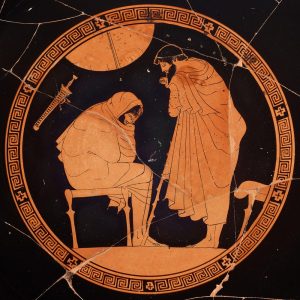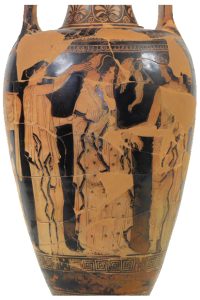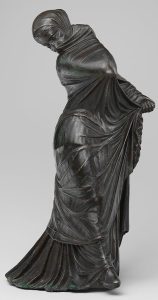5 The Himation: Modesty, Status and Agency in Ancient Greek Society
Lyndsay Turner
What can a piece of cloth unveil about a civilization? While the himation may appear to be no more than a rectangular scrap of fabric, woven into its folds are stories of identity, status, and power. From austere drapery to carefully arranged veils of brides, this garment was anything but simple.
The himation, a large rectangular garment worn either as an outer cloak or on its own, was one of the most enduring garments within Greek society. It was worn by both men and women with varying agency, across centuries and different regions. While its immediate appearance may suggest uniformity and simplicity, its varied uses conveyed important information about an individual in regards to their status in society, gendered roles, and ritual significance. The way in which an individual wore the himation, from its draping, coverage, and ornamentation, were all markers of identity, modesty (or its absence), and social control. This chapter will explore these functions of the himation, analyzing its role as a symbol of Greek identity, a tool of gendered modesty, and a garment of philosophical and ritual significance.
Definition and Use
The himation was a flexible garment which could be worn alone, or over a chiton, or peplos. The way an individual draped it was not merely a matter of personal style but instead reflected broader social and cultural ideals. More elaborate himatia styles, such as those with decorative borders, were associated with higher-class fashions and women, while simpler drapery and solid linens portrayed austerity, especially among philosophers and statesmen, as noted by Lloyd Llewellyn-Jones.
Greek Identity and Simplicity
The himation played a significant role in defining Greekness through its own means of simplicity. Contrasting to the highly ornamented clothing of foreigners, the himation was generally worn unadorned, symbolizing a restrained modesty. Herodotus explains the juxtaposition of Greek dress with that of the Persians, stating that their garments were generally embroidered (Hdt. 7.61.1). Conversely, the everyday Greek himation would be worn alone and not overly embellished, reflecting the Greeks’ perception of themselves as disciplined and moderate even in dress.
Modesty and Gendered Manipulation
One of the key aspects of the himation was its ability to signify modesty, specifically, through veiling. This use was a crucial social expectation for women, as it signified respectability and sexual virtue. The veil, which was often created by draping a himation over the head and partially covering the face, was not merely a passive marker of modesty, but could also be used to manipulate one’s expression and to conceal intent. In Homer’s Odyssey, Penelope veils herself before addressing the suitors as a means of controlling the perception of her emotions and intentions (Hom. Od. 1.330-335).
In a similar way to women, courted male youths would use the draping of the himation to indicate both their desirability and respectability. Whereas women’s modesty was often closely tied to the social expectations of chastity and seclusion, for young men, their use of a himation-veil signalled a controlled and idealized form of beauty and virtue, making them suitable objects of admiration within courtship.

Gloria Ferrari argues that the manipulation of clothing depicted within vase paintings and sculptures reveals a spectrum of modesty and display, given that the himation can both conceal the wearer and invite attention.
A striking example of men veiling is in Fig.4.1, depicting a mourning Achilles wrapped in a himation, while Odysseus who stands to the right, wears it more traditionally. In a moment of self-reflection, we can imagine that Achilles is mourning the death of Patroclus. Here we see that gestures of veiling could be used for emotional containment during periods of sorrow, which reinforces the idea that the himation was a tool for self-expression.
Philosophers and The Himation
During the Classical period, the himation becomes increasingly associated with the philosopher. Figures such as Socrates and Diogenes rejected luxury, embracing the simple himation as an embodiment of their ideals and democracy, in contrast to the ornate and luxurious garments favoured by older aristocrats. In Plato’s Republic, Socrates laments the younger generation’s shift from the austere himation, to softer, and “more elaborate garments” (Plat. Rep. 8.557), viewing it as a symptom of moral decay. This rejection of overindulgence and a commitment to simplicity made the himation the perfect garment. According to Douglas Cairns, it showcased their philosophical dedication to wisdom, self-sufficiency and the pursuit of virtue over material excess.
Ritual and The Himation

Beyond daily wear, the himation also played a significant role in religious and ritual settings, especially within ancient Greek marriage rituals. During marriage preparations, a bride would be draped with a himation and escorted from her father’s home and into her husband’s residence, marking the rite of passage into marriage. The ritual culminated in the unveiling of the bride, called anakalypteria. Fig. 4.2, an Attic red-figure loutrophos, visually encapsulates the moment of anakalypteria within the marriage ritual.
The central figure depicts a bride whose himation-veil is being lifted, while her husband is depicted grabbing her hand and gazing into her eyes. This ceremonial unveiling marks a transformation from maiden to wife. The prominence of the drapery reinforces the importance of the himation beyond daily wear.
Beyond marriage rituals, the act of veiling and heavy draping of the himation also carried deeper religious connotations, such as with priests veiling during the performance of a sacrifice.
Similarly, within the ecstatic rites of Dionysian mystery cults, veiling could serve both as the ritual act of transformation, as well as the practical act of concealing one’s identity. Initiates, particularly women, are often depicted in art as being heavily draped with their faces partially or fully concealed, as if shedding their identity to take part in the rituals. In both sacred and secular contexts, the himation was not merely a garment but a medium for indicating a change of state.
Shrouded in Revelry: What Secrets Did the Himation Conceal?

This Hellenistic bronze statuette captures a dancer, her body enveloped in layers of flowing fabric. The sheer veil surrounding the contours of her face plays with the intentional concealment and display. The himation clings to her form, moving with her, showcasing an intimate relationship between fabric and the performance. The statuette is identified as one of the professional entertainers of Alexandria, embodying the boundaries between art, ritual and spectacle. Was she an entertainer performing for the elite, or in a festival? A participant in an initiation? Is she lost in the trance of the ritual, or is she shielding herself from the gaze of those uninitiated? Veiling, whether functional or with symbolism, could blur the lines of the seen and unseen, mortal and godly. In the dim glow of torch-lit meadows in the forest, did the twirling, shrouded figures seem more than human? The statuette of the veiled dancer leaves us with more questions that answers, a testament to the layered meanings of drapery in the ancient world.
That’s a Wrap
The himation was a dynamic tool of communication, identity, and social regulation within Greek society. Its use transcended practicality, shaping and mirroring key ideals within ancient Greek culture, from thoughts on modesty and restraint, and enabling self-expression through its manipulation. A symbol of Greek identity, the himation stood in contrast to the elaborate and ornamental foreign dress of non-Greeks. For the philosophers, the himation embodied the rejection of overconsumption, in favour of modesty and virtue. Lastly, its role in religious and marriage rites embodies its deep-rooted significance in society. Whether used to drape simply in daily usage, as a veil in marriage, or to shroud the initiates of mystery cults, the himation was a garment used both to conceal and reveal, shaping the interpreter’s idea of the individual.
Bibliography and Further Reading
Cairns, D. L. 1993. Aidos: The Psychology and Ethics of Honour and Shame in Ancient Greek Literature. Oxford: Oxford University Press.
Ferrari, G. 2002. Figures of Speech: Men and Maidens in Ancient Greece. Chicago: University of Chicago Press.
Lee, M. M. 2015. Body, Dress, and Identity in Ancient Greece. Cambridge: Cambridge University Press.
Llewellyn-Jones, L. 2003. Aphrodite’s Tortoise: The Veiled Woman of Ancient Greece. Swansea: Classical Press of Wales.

